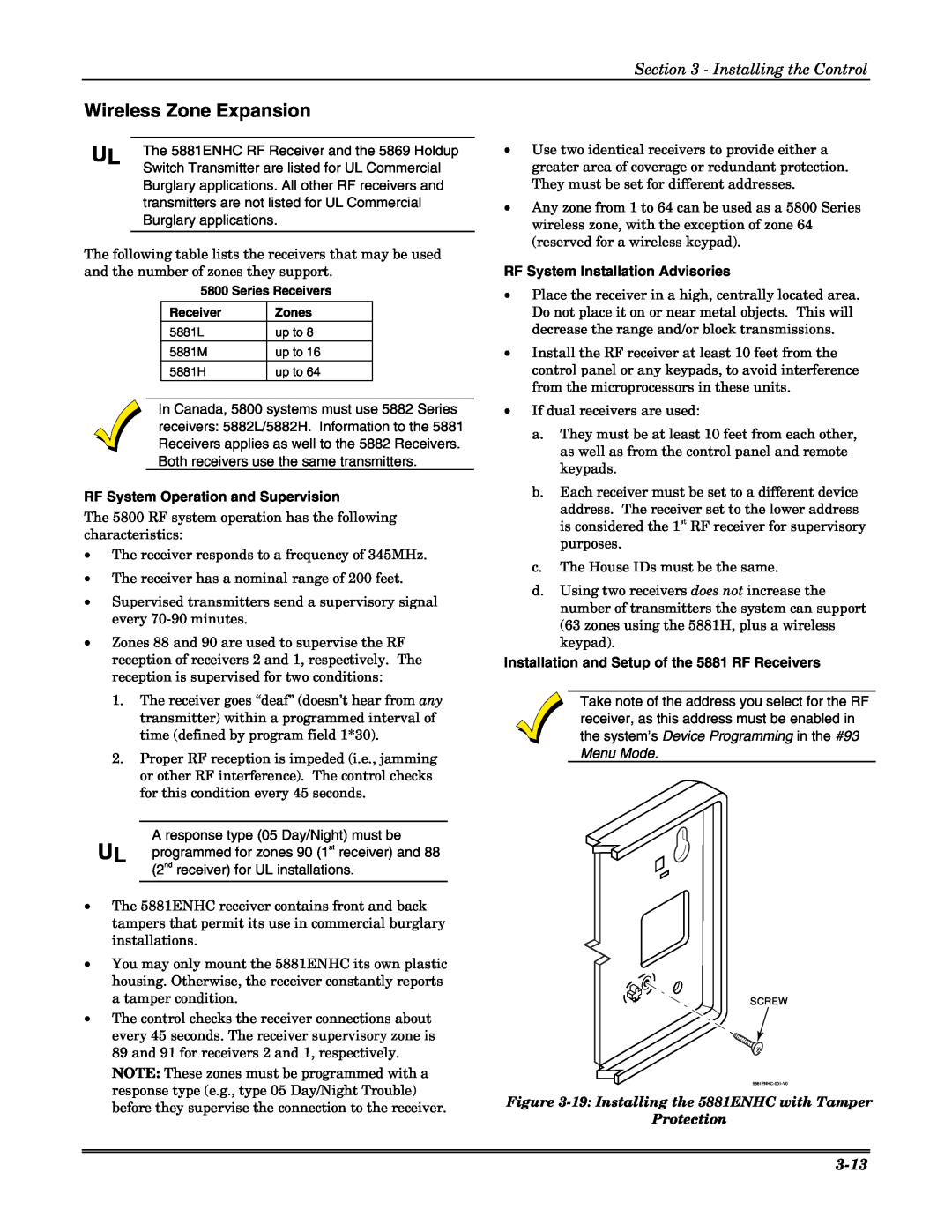
Section 3 - Installing the Control
Wireless Zone Expansion
UL | The 5881ENHC RF Receiver and the 5869 Holdup | |
Switch Transmitter are listed for UL Commercial | ||
| ||
| Burglary applications. All other RF receivers and | |
| transmitters are not listed for UL Commercial | |
| Burglary applications. | |
|
|
The following table lists the receivers that may be used and the number of zones they support.
5800 Series Receivers
Receiver | Zones |
5881L | up to 8 |
5881M | up to 16 |
5881H | up to 64 |
In Canada, 5800 systems must use 5882 Series receivers: 5882L/5882H. Information to the 5881 Receivers applies as well to the 5882 Receivers. Both receivers use the same transmitters.
RF System Operation and Supervision
The 5800 RF system operation has the following characteristics:
•The receiver responds to a frequency of 345MHz.
•The receiver has a nominal range of 200 feet.
•Supervised transmitters send a supervisory signal every
•Zones 88 and 90 are used to supervise the RF reception of receivers 2 and 1, respectively. The reception is supervised for two conditions:
1.The receiver goes “deaf” (doesn’t hear from any transmitter) within a programmed interval of time (defined by program field 1*30).
2.Proper RF reception is impeded (i.e., jamming or other RF interference). The control checks for this condition every 45 seconds.
UL | A response type (05 Day/Night) must be |
nd | |
| programmed for zones 90 (1st receiver) and 88 |
| (2 receiver) for UL installations. |
|
|
•The 5881ENHC receiver contains front and back tampers that permit its use in commercial burglary installations.
•You may only mount the 5881ENHC its own plastic housing. Otherwise, the receiver constantly reports a tamper condition.
•The control checks the receiver connections about every 45 seconds. The receiver supervisory zone is 89 and 91 for receivers 2 and 1, respectively.
NOTE: These zones must be programmed with a response type (e.g., type 05 Day/Night Trouble) before they supervise the connection to the receiver.
•Use two identical receivers to provide either a greater area of coverage or redundant protection. They must be set for different addresses.
•Any zone from 1 to 64 can be used as a 5800 Series wireless zone, with the exception of zone 64 (reserved for a wireless keypad).
RF System Installation Advisories
•Place the receiver in a high, centrally located area. Do not place it on or near metal objects. This will decrease the range and/or block transmissions.
•Install the RF receiver at least 10 feet from the control panel or any keypads, to avoid interference from the microprocessors in these units.
•If dual receivers are used:
a.They must be at least 10 feet from each other, as well as from the control panel and remote keypads.
b.Each receiver must be set to a different device address. The receiver set to the lower address is considered the 1st RF receiver for supervisory purposes.
c.The House IDs must be the same.
d.Using two receivers does not increase the number of transmitters the system can support (63 zones using the 5881H, plus a wireless keypad).
Installation and Setup of the 5881 RF Receivers
Take note of the address you select for the RF receiver, as this address must be enabled in the system’s Device Programming in the #93 Menu Mode.
SCREW
Figure
Protection
